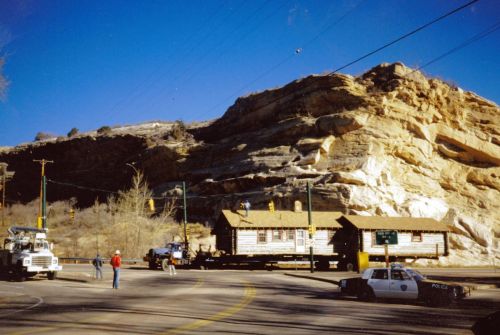
Quarry #10 near Morrison, or Clay Saurian #1, as drawn by Rev. Arthur Lakes.
One hundred forty years ago this month, Morrison entered the history of paleontology in an impressive way, with the discoveries made by Rev. Arthur Lakes on the hogback north of our small town.
On a Tuesday in late March 1877, a young professor made a discovery at what is now Dinosaur Ridge, near Morrison in Jefferson County, Colorado. This discovery transformed American geology and started a revolution in our understanding of dinosaurs. It also sparked a dinosaur “gold rush” that led the great scientific institutions of the East to turn their sights west. The fabulous wealth of such men as George Peabody, Andrew Carnegie, and Marshall Field was unleashed in a quest for the biggest and most bizarre dinosaurs to fill their museums. —Hunt, Lockley, & White, 2002

Arthur Lakes sketch of the quarries along the west slope of the Dakota hogback, from a letter to in 1879.
Ultimately, Lakes agreed to send the dinosaur bones discovered at Morrison to Professor O.C. Marsh at Yale’s Peabody Museum. For the next two years, Lakes and colleagues (including Benjamin Mudge, in white in above drawing) continued to send bones and reports to Marsh documenting their work at 14 sites along the hogback. Lakes also recorded their activities in his diaries, leaving us an extensive historical record of Morrison’s part in the “Bone Wars” of the late 19th century.
Lakes sent his first letter to Marsh on April 2nd, 1877. This letter told Marsh about the discoveries and their position in the sequence of rocks. He included good drawings of two partial bones and a detailed sketch of the geology of the area now known as Red Rocks Park and Dinosaur Ridge. —Hunt, Lockley, & White, 2002
Only four of the quarries yielded significant discoveries. Quarry #10, the Clay Saurian, is known for Apatosaurus ajax (YPM 1860). This site near the southern end of Dinosaur Ridge was relocated in 2002 and has been worked since then by teams from the Morrison Natural History Museum. Based on Lakes’s sketches of the hogback, his diaries, old photos, and field surveys, the location of Quarry #1 was identified in September of 2009 (Ghist & Simmons, 2010). The rediscovered quarry site was named a county landmark in 2014. This and other sites along Alameda Parkway are managed and interpreted by the Friends of Dinosaur Ridge.

National Natural Landmark Plaque on Dinosaur Ridge
The entire “Morrison Fossil Area” was named a
National Natural Landmark in 1973. In 2011, the Landmark was expanded to include Late Cretaceous track sites near Golden, and is now called the “
Morrison-Golden Fossil Area.”
References
Ghist, John, Simmons, Beth. 2010. Rediscovering Arthur Lakes’ Historic Lost Quarries at Dinosaur Ridge (Morrison, Colorado) Presented at 2010 GSA Denver Annual Meeting, 1 November 2010.)
Hunt, Adrian, Lockley, Martin and White, Sally. 2002. Historic Dinosaur Quarries of the Dinosaur Ridge Area Friends of Dinosaur Ridge and the University of Colorado at Denver Trackers Research Group.
JCHC. 2014. Preserving Prehistory: Friends of Dinosaur Ridge, Meyer Award for Historic Preservation. In Historically Jeffco magazine, Vol. 35: 39-40. Jefferson County Historical Commission.
JCHC. Dinosaur Ridge Describes Dedication of National Natural Landmark in May 2004.























